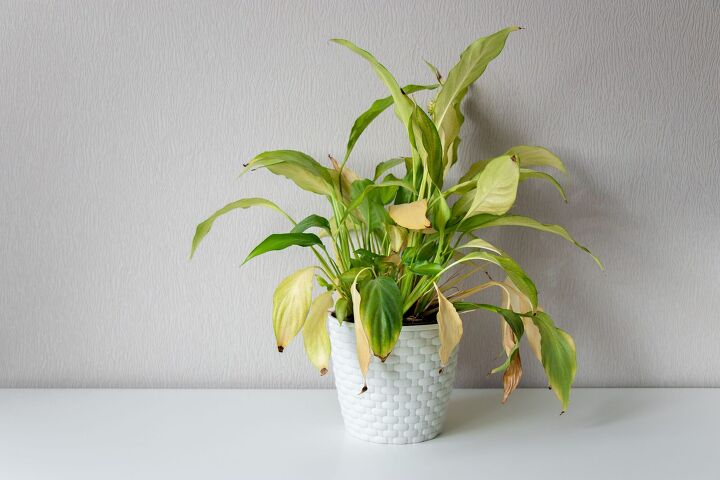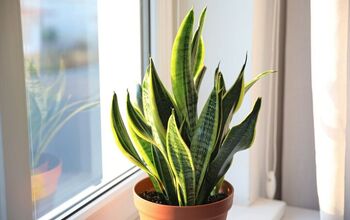Can Dried-Out Plants Be Revived?

Finding dry and withering leaves on your favorite plants can be discouraging to any homeowner who takes pride in their garden. Dried-out plants may appear dead and ugly, but that doesn’t always mean that they are. Can dried-out plants be revived?
Dried-out plants can be revived if you soak them in water and put them in the ideal sunlight position. Prune the dead leaves and leave the plant in as much sunlight as possible. Repot the plant if the soil is dried out, as it’s easy to revive plants with healthy soil.
It’s common for plants to struggle when you move to another house. In that case, you may need to experiment to find the ideal sunlight position and watering schedule. Follow along as we explore everything you need to know about reviving dried-out plants.
Can A Plant Recover From Drying Out?
A plant can recover from drying out. When a plant dries out, the leaves typically wither and become brittle. This makes many homeowners assume that the plant is beyond repair, but that isn’t always the case.
Just because the leaves and soil are dry, it doesn’t mean the roots and stem aren’t healthy. Many plants have resilient roots that can stay viable even when the rest of the plant looks dry and dead. However, the sight of withering plant leaves is a sign that you need to act and revive the plant before it’s too late.
How Long Does It Take To Revive A Dried-Out Plant?
It can take up to 4 weeks to revive a dried-out plant, depending on the severity of the problem. The process is faster if the dried plant has a healthy stem, stalk, and root system. You must soak a dried plant with much more water than you’d typically use while tending to your garden.
In some cases, you may need to repeat the process over several days. After that, your plant will likely still looks dry and dead for at least a week. You can expect it to take a month before your dried plant looks as good or better than it did before.
Healthy plants need an hour to rehydrate after you water them. However, a plant that is too dry won’t start rehydrating until you soak it many times. While it can take as little as a day to revive a dried plant, you should exercise patience as the process can take weeks.
How To Save A Dried-Out Plant
Saving a dry plant is easier than it sounds, but it requires lots of patience. The results can take weeks to become obvious. Let’s look at the key steps it takes to revive dried-out plants.
1. Examine The Stalk And Roots
The first step to revive a dry plant is to examine the stalk and roots. This can tell you whether it’s even worth trying to save your plant. Look for green spots in the stem and stalk that indicate the plant is healthy enough to revive.
However, your plant is likely beyond repair if the roots are brittle. Look for root flexibility, and proceed if the roots look healthy.
2. Remove Dead Leaves
Remove dead leaves from the plant before you revive it. Only prune the leaves that are entirely dry, as some of the weaker leaves with dry spots may bounce back. Use your best judgment and remove leaves that are dry enough to crumble when you touch them.
3. Soak The Plant
Now it’s time to soak the plant if it’s healthy enough to salvage. This is much easier with potted plants, as over-watering dry plants in a soil bed can harm nearby plants in many cases. Move your potted plant indoors and place it in a sink.
Pour a lot of water into the pot and let it rush through the drainage holes. Soak the soil, stems, and remaining leaves. This is overkill under normal conditions, but it’s necessary to soak a dried-out plant.
Leave the plant out in the sun after you soak it, so the soil doesn’t stay soggy for too long. You may need to soak the plant again over the next week if the soil dries out quickly. After that, you can typically return to your normal watering schedule.
4. Reposition The Plant
Is your plant getting too much or too little sunlight? If so, you must move the plant so the sunlight exposure is ideal for healthy growth. This is easier to do with potted and hanging plants, but you can safely uproot some plants in your garden without killing them.
Move sun-sensitive plants to shaded areas and reposition plants that require lots of sunlight to open areas without much shade. Adjust your watering schedule as well based on what is ideal for the specific plant.
5. Repot The Plant
In some cases, the soil in the pot is tarnished. This can happen if it becomes too dry and then you soak it too much to overcompensate. Depending on how long you’ve had that soil in the pot, it may no longer have enough nutrients to support healthy plant growth.
In that case, it’s the perfect time to repot the plant so you can ensure the soil is healthy and full of nutrients. Look for nutrient-dense soil for the best results. Make sure to use fertilizer and plant food in conjunction with water so your plant takes to the new pot quickly.
When Is It Too Late To Revive A Plant?
It’s typically too late to revive a plant if the stalk is stiff or brittle and the stem has no green. You can also tell that your plant is beyond repair if the roots and stalk are fragile and flaky. You can typically save dried-out plants as long as the stalk and roots are healthy even if the leaves are dry and withering.
Unfortunately, it’s hard to tell whether you can save a tree because the roots are typically less accessible. Check the roots, stalks, and stems of the plants in your garden and home to see if you can still revive them. As long as they are still somewhat flexible, green, and sturdy, you can likely revive the plant with lots of water and sunlight.
How To Save Dying Plants Indoors
The best way to save dying plants indoors is to move them closer to a window with the ideal sunlight exposure. Put plants that require lots of sunlight by a south-facing window for optimal growth. Plants that don’t need as much sunlight will thrive by north-facing windows.
You can help save dying plants indoors if you install grow lights. Not only can this save them, but grow lights can make your indoor plants grow faster. It’s also important to do some research and find out how much water each of your indoor plants needs for optimal growth.
Overwatering and underwatering your plants can quickly kill them. Chances are, each of your indoor plants likely has unique watering needs.
I Moved And Now My Plants Are Dying
If your plants are dying after you moved, it could be because of the new sunlight conditions. For example, maybe your last home had less shade and more sunlight exposure. There is a chance that your new home’s yard doesn’t get as much sunlight, and that can hinder plant growth.
Your plants are also likely to struggle if you move to a home in a different climate zone. Some plants cannot thrive in certain climates, and their growth can halt if you bring them to an area with too much or too little sunlight and rain. In some cases, your plants will die after you move if your new home is prone to pests.
Certain pests like aphids and spider mites can cause your plants to wither and die. Luckily, you can get rid of spider mites with several household remedies and chemicals.
Summing It Up
Dried-out plants can be revived, but it typically requires soaking them. You must also prune dead leaves and adjust the plant’s location to where it will get the optimal level of sunlight. Consider using grow lights if your indoor plants struggle to thrive.
Be patient, as it can take up to 4 weeks to revive a dry plant in some cases. Pay attention to the roots and make sure they are flexible enough. This can indicate that you can revive the plant even if it looks dead.
Related Guides

Nick Durante is a professional writer with a primary focus on home improvement. When he is not writing about home improvement or taking on projects around the house, he likes to read and create art. He is always looking towards the newest trends in home improvement.
More by Nick Durante

























![12 Washing Machine Brands to Avoid [with Recall Data]](https://cdn-fastly.upgradedhome.com/media/2023/07/31/9075781/12-washing-machine-brands-to-avoid-with-recall-data.jpg?size=350x220)

